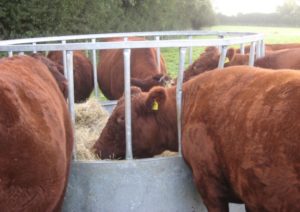Supplementing Beef Cattle At Grass
29 June 2018 As summer progresses the quantity and nutritional quality of grass declines. This year, grass growth has fallen off quite considerably as soils run out of moisture. In spring and early summer there was sufficient good quality grass for animal production and for conservation as silage or hay. By now and into early autumn, animal growth rate will be declining on grass alone. At some stage, it is necessary to supplement the grazing if to maintain cattle growth rates. However too much and it will simply substitute grass intakes and make weight gain more expensive.
As summer progresses the quantity and nutritional quality of grass declines. This year, grass growth has fallen off quite considerably as soils run out of moisture. In spring and early summer there was sufficient good quality grass for animal production and for conservation as silage or hay. By now and into early autumn, animal growth rate will be declining on grass alone. At some stage, it is necessary to supplement the grazing if to maintain cattle growth rates. However too much and it will simply substitute grass intakes and make weight gain more expensive.
The level of grass supplementation will depend on:
- The type of cattle and target growth rates
- The amount of grass available
- What kind of grass growing season we get from July onwards
What are the aims for your cattle?
Finishing cattle targeting upwards of 1kg daily liveweight gain will now need supplemented at grass. If grass is in low supply or of poor quality, then consider putting out an ad-lib hopper with concentrates – take care to introduce feeding slowly and to cattle that have a full belly to avoid gorging and then make sure hoppers do not run out thereafter otherwise this process needs to be repeated.
If feeding ad-lib, it is advisable to have a ring of straw available as well as long roughage if grass is poor (or on a wet day!?!) when cattle will tend to congregate round a feeder rather than graze.
Bringing them in the house to finish may also be an option. Certainly, some groups of cattle’s performance will have been disappointing over this extended dry spell.
If grass remains plentiful and of good quality then growing cattle could still be growing at up to 0.8kg/day gain. However, this requires good growing conditions and very well managed grazing.
Karen Stewart, Karen.Stewart@sac.co.uk
Sign up to the FAS newsletter
Receive updates on news, events and publications from Scotland’s Farm Advisory Service
